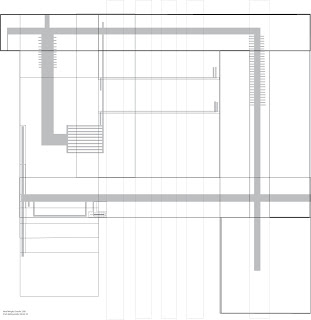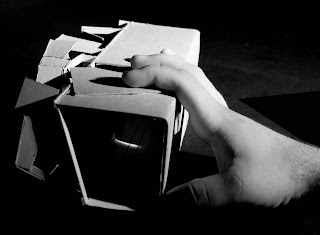
Thursday, September 30, 2010
Sunday, September 26, 2010
Friday, September 24, 2010
Wednesday, September 22, 2010
Friday, September 17, 2010
Friday, September 10, 2010
"For an Architecture of Reality" by Michael Benedikt
What is the reality Michael Benedikt writes about?
The reality of symbols as a reference or not. He discusses the reality of dreams vs. reality television; both are real however, the physical reality is more tangible and less of a mental phenomenon. Reality television simply exists with less symbolism than the reality of dreams.
- Symbolism is human nature thus unavoidable.
Benedikt describes degrees of reality in architecture as: Architecture of Dreams, Architecture of Games, Architecture of Illusions, Architecture of Enactments and Architecture of Jokes. What are some example buildings that fall under these categories?
The Architecture of Dreams: "Emilio's Folly"
The Architecture of Games: "The Manhattan Transcripts"
The Architecture of Illusions: "Mural, Krayer Building"
The Architecture of Jokes: "Commercial Building" - Austin, TX
The Architecture of Re-Enactment: "University of Houston School of Architecture"
The Architecture of Pre-Enactment: "Centre Pompidou" - Paris
Benedikt describes “direct esthetic experience of the real” as being moments without symbolism. Where in our environment does symbolism occur and where in our environment is symbolism absent? What is an example of this situation?
Symbolism occurs in religious architecture (i.e. Catholic Churches), advertising, legislative buildings with prominent features alluding power and substance. Another example is more literal symbolism such as the top of the "Chrysler building" being designed to look like the spokes of an automobile (Chrysler's product)
- Institutions also tend to represent long standing tradition and academic valor.
- Francises tend to represent the overall look of a company providing onlookers with a reference frame.
Non-symbolic spaces include utilitarian spaces such as parking lots, vacant lots and the area around or under utilities installations.
- Most spaces do carry a sense of symbolism which can change how the structure is perceived from person to person.
Although Benedikt’s position pulls examples from the 70‘s and 80‘s to illustrate that an architecture of reality is polar to the post-modern architecture movement, this condition continues to exist today. Where in the city would be examples of an architecture of reality and post-modern architecture?
An architecture of reality is represented in city sewer systems, city utilitarian architecture and parking lots. Post-modern architecture, or architecture that often represents something else, is found in modern suburban homes and themed attractions such as the hotels on the Las Vegas strip.
The four components that define the “realness” of an architecture for reality are: presence, significance, materiality, and emptiness (in two categories). How do these components relate to architecture? and What are some examples of architectural elements that make up these conditions?
1. Presence:
- A building's right to be there or appropriateness
- A structure "stands right where it needs to be"
2. Significance:
- The Architecture's collective value & importance
- The Architecture's ability to be used as a reference
- "How they continue to be apart of people's lives" (referring to buildings)
- (i.e. The Dairy Barn on Campus)
3. Materiality:
- Genuine material being shown and used in design/ construction
- Functionality having a larger effect on material selection (i.e. using a glass ceiling or wall instead of a glass floor)
4. Emptiness:
- Meaning one: not full (applied)
- Meaning two: "mod", with gravitation, to be filled in the future, substantial space in need.
"Points & Lines" by Stan Allen
Stan Allen describes field conditions as “bottom-up phenomena: defined not by overarching geometrical schemas but by intricate local connections.” What are some field condition examples that can be found in the road systems of Lubbock?
Field conditions in Lubbock include: the grid layout of the roads, the road system's orthogonal layout, stop signs and the numbering/ lettering patterns of the streets.
- Stop signs are a field condition in their relationship to the intersection.
- The degree of road taper (or grading) is a practical road condition facilitating runoff in Lubbock's flat terrain. Which proves that solutions to problems can be field conditions.
In part 1, Allen distinguishes a geometric relationship of classical architecture from an algebraic combination of the Cordoba Mosque. How do these two architectural examples differ?
In the case of the Cordoba Mosque, the units (arches) refer back to the whole. The arch structural pattern started with one arch and grew in a algebraic model.
- Geometric relationships exist as stable patterns (i.e. all angles of a triangle adding up to 180 degrees) vs. Algebraic combinations which introduce unknown variables.
The paving and paths exist as a field condition. Stadium seating, people filling the seats and crowd behavior exist as field conditions as well.
- parking lots with the classic 8'x16' space are well known, utilitarian field conditions.
How does a field condition stand to redefine the relation between figure and ground?
Figure ground representations are simplistic filled vs. non-filled space represented by the positive and negative space of a drawing. One famous figure ground drawing is Giambattista Nolli's figure ground representation of Rome. Field conditions add a dimension relationships in spaces and the element of usage.
Thursday, September 2, 2010
Subscribe to:
Posts (Atom)













































